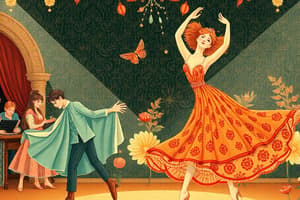Podcast
Questions and Answers
What is the Rhythm Section?
What is the Rhythm Section?
- Instruments that provide the rhythmic foundation (correct)
- Instruments that play the melody
- A type of improvisation
- None of the above
What instruments are typically found in the Front Line?
What instruments are typically found in the Front Line?
Saxophone, clarinet, trumpet, trombone.
Syncopation refers to accenting a normally weak beat.
Syncopation refers to accenting a normally weak beat.
True (A)
What is Vibrato?
What is Vibrato?
Define the term 'Chorus' in jazz.
Define the term 'Chorus' in jazz.
A Riff is a long melodic phrase.
A Riff is a long melodic phrase.
What is the Walking Bass?
What is the Walking Bass?
What does Stop Time refer to in jazz?
What does Stop Time refer to in jazz?
What is a Chart/Arrangement in music?
What is a Chart/Arrangement in music?
Collective Improvisation occurs when all members improvise at once.
Collective Improvisation occurs when all members improvise at once.
What characterizes a Boogie-Wooie style?
What characterizes a Boogie-Wooie style?
What is a Solo Break in music?
What is a Solo Break in music?
Double Time refers to a speed that is twice as slow.
Double Time refers to a speed that is twice as slow.
Define Chord Changes / Chord Progression.
Define Chord Changes / Chord Progression.
What is a Jazz Standard?
What is a Jazz Standard?
What does Modulation mean in music?
What does Modulation mean in music?
What is Voicing in the context of chords?
What is Voicing in the context of chords?
What is Swing Rhythm based on?
What is Swing Rhythm based on?
What are Chops in music?
What are Chops in music?
What defines a Turnaround in music?
What defines a Turnaround in music?
What does Voice Leading refer to?
What does Voice Leading refer to?
What are Block Chords?
What are Block Chords?
Define Comping in jazz.
Define Comping in jazz.
What is Scat Singing?
What is Scat Singing?
What characterizes a Ballad?
What characterizes a Ballad?
What is a Jam Session?
What is a Jam Session?
What does a Ride Cymbal Pattern do?
What does a Ride Cymbal Pattern do?
What is an Arpeggio?
What is an Arpeggio?
What is a Coda?
What is a Coda?
Define a Fake Book.
Define a Fake Book.
What does 'Trading 4's' mean in jazz?
What does 'Trading 4's' mean in jazz?
What is Harmonic Rhythm?
What is Harmonic Rhythm?
What is a Vamp?
What is a Vamp?
What does Modal Jazz refer to?
What does Modal Jazz refer to?
What is Bossa Nova?
What is Bossa Nova?
Flashcards are hidden until you start studying
Study Notes
Jazz Terms Overview
- Rhythm Section: Consists of instruments providing rhythmic and harmonic foundation; includes piano, bass, guitar, drums, tuba, and banjo.
- Front Line: Instruments that play melody and improvise solos; includes saxophone, clarinet, trumpet, and trombone.
- Syncopation: Emphasizing normally weak beats within music, creating a rhythmic surprise.
- Vibrato: Pitch fluctuation of vocals or instruments for expressive effects.
- Chorus: Main section of a song that repeats multiple times for solos.
- Riff: A repeated short melodic phrase, often utilized by soloists or groups.
- Two-Feel: Rhythmic style in which distinct tones are played on each beat of the measure.
- Walking Bass: Bass technique with unique tones played on each beat, creating a continuous feel.
- Stop Time: Accompaniment technique where the ensemble accents the first beat of each bar, allowing soloists to shine.
- Chart/Arrangement: Detailed musical composition outlining individual parts for each musician.
- Collective Improvisation: A simultaneous improvisation by all group members, enhancing ensemble interaction.
- Boogie-Wooie: Piano style featuring repetitive left-hand bass and improvisational right-hand melodies.
- Solo Break: Brief pause in music allowing soloists to begin improvisation.
- Double Time/Double Time Feel: Experience where the tempo is perceived as twice as fast.
- Chord Changes/Chord Progression: Series of chords forming the framework for melody and improvisation.
- Jazz Standard: Established repertoire of tunes known by most jazz musicians, often composed for Broadway or Hollywood; commonly follows a 32-Bar AABA structure.
- Modulation: Transition from one key to another within a piece of music.
- Voicing: Specific selection of pitches used in chord construction.
- Swing Rhythm: Based on triplet subdivision, creating a unique feel in jazz.
- Chops: Slang for technical skill or proficiency on an instrument.
- Turnaround: Sequence of chords designed to establish a key center.
- Voice Leading: Description of how individual notes in chords progress to subsequent chords.
- Block Chords: Chords played in parallel motion, creating a harmonically rich sound.
- Comping: Accompanying style in which rhythm section supports soloists.
- Scat Singing: Vocal improvisation using nonsensical syllables, typical in jazz solos.
- Ballad: Slow, emotional piece typically characterized by avery slow tempo.
- Jam Session: Informal gathering for musicians to improvise solo on jazz standards, fostering creativity.
- Ride Cymbal Pattern: Drumming technique serving as the primary time-keeping element.
- Arpeggio: Playing notes of a chord in sequence rather than simultaneously.
- Coda: Concluding segment of a piece, often differing from the main structure.
- Fake Book: Collection of songs in simple form, showing only melody and chord progressions for performers.
- Trading 4's (or 8's): When musicians alternate improvised solo statements of 4 or 8 bars.
- Harmonic Rhythm: Speed at which chords transition in the tune.
- Vamp: Brief repeated chord progression often employed in introductions and endings.
- Modal Jazz: Style of jazz relying on modes rather than traditional chord progressions.
- Bossa Nova: Brazilian music genre blending samba with enriched harmonic and melodic elements.
Studying That Suits You
Use AI to generate personalized quizzes and flashcards to suit your learning preferences.




